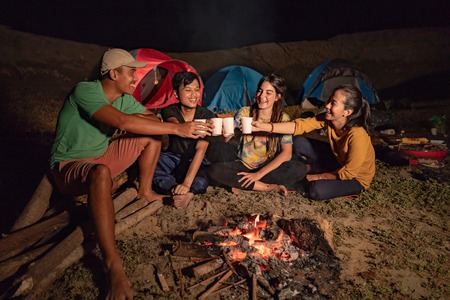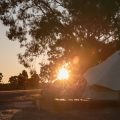1. Understanding What Dispersed Camping Is
Before you can start looking for legal dispersed camping spots on BLM (Bureau of Land Management) land, it’s important to understand what dispersed camping actually means. Dispersed camping refers to camping outside of designated campgrounds. Instead of staying at a developed site with amenities like picnic tables, fire rings, and restrooms, youre setting up camp in more remote, undeveloped areas.
How Dispersed Camping Differs from Traditional Campground Stays
There are some key differences between dispersed camping and traditional campground camping. Heres a quick comparison:
| Feature | Dispersed Camping | Campground Camping |
|---|---|---|
| Location | Undeveloped public lands (e.g., BLM areas) | Designated sites with marked boundaries |
| Amenities | No amenities (bring your own everything) | Often includes bathrooms, water, and fire pits |
| Reservations | No reservations required | May require advance booking |
| Cost | Usually free | Fees typically apply |
| Crowds | Low—more privacy and solitude | Higher—more people and noise |
Why Its Popular on BLM Land
Dispersed camping is especially popular on BLM land because these public lands cover millions of acres across the western United States and are managed specifically to allow recreational use. Many campers enjoy the freedom to pick their own spot, the opportunity to disconnect from busy campgrounds, and the chance to explore nature more intimately. Plus, since most dispersed camping on BLM land is free, it’s also budget-friendly.
Key Points to Remember:
- You’ll need to be fully self-sufficient—bring water, food, shelter, and tools for waste disposal.
- Follow Leave No Trace principles to help protect natural resources.
- Stay within legal boundaries and avoid private property or restricted zones.
Tip:
If you’re new to dispersed camping, start near a known access road or trailhead on BLM land before venturing farther into remote areas.
2. Know the Rules and Regulations of BLM Lands
Before heading out on your dispersed camping adventure, its important to understand the basic rules that apply to Bureau of Land Management (BLM) lands. These guidelines help protect natural resources and ensure everyone has a safe, enjoyable experience.
Stay Limits
Most BLM areas have a 14-day stay limit within a 28-day period. This means you can camp in one spot for up to 14 days, but then you need to move at least 25 miles away if you want to continue camping on BLM land. This rule helps reduce environmental impact and gives others a chance to enjoy the area.
Typical Stay Limit Guidelines
| Rule | Description |
|---|---|
| Maximum stay | 14 consecutive days in one location |
| Relocation distance | You must move at least 25 miles after 14 days |
| Total period | The 14-day limit resets after 28 days |
Fire Restrictions
Fire rules can vary depending on the season and local conditions. Always check with the local BLM field office or their website before lighting a campfire. In many areas, fire bans are common during dry months to prevent wildfires. Even when fires are allowed, use established fire rings if available, keep fires small, and never leave them unattended.
Tips for Safe Campfires
- Use existing fire rings whenever possible
- Keep water and a shovel nearby to extinguish flames
- Avoid building fires during windy conditions
- Douse the fire completely before leaving—make sure it’s cold to the touch
Leave No Trace Principles
The Leave No Trace principles are key to keeping BLM lands clean and natural for future campers. These simple practices help reduce your impact on the environment:
- Plan ahead and prepare: Know the area’s regulations and weather conditions.
- Travel and camp on durable surfaces: Stick to existing roads and campsites.
- Dispose of waste properly: Pack out all trash, leftover food, and litter.
- Leave what you find: Don’t take rocks, plants, or cultural artifacts.
- Minimize campfire impacts: Use a stove or established fire ring instead of building new ones.
- Respect wildlife: Observe animals from a distance and store food securely.
- Be considerate of other visitors: Keep noise down and yield the trail when hiking.
Understanding these rules helps you enjoy your trip without causing harm to nature or getting into legal trouble. Always do your homework before setting up camp on BLM land—it’s part of being a responsible camper.
![]()
3. Using Online Tools and Maps to Locate BLM Dispersed Camping Areas
When youre planning a dispersed camping trip on BLM (Bureau of Land Management) land, knowing where its legal to camp is key. Luckily, there are several online tools and maps that make it easier than ever to find the right spot. Whether youre a weekend warrior or a full-time vanlifer, these resources can help you stay on public land legally and responsibly.
Official BLM Websites and Maps
The best place to start your search is the official BLM website. Each state has its own BLM page with up-to-date maps, land use rules, and contact information for local offices. Look for maps labeled “Surface Management Maps” or “Recreation Maps”—these show boundaries of BLM-managed lands and often highlight areas open to dispersed camping.
How to Use the BLM Website
- Go to blm.gov
- Select your state from the map or drop-down menu
- Navigate to the “Recreation” or “Camping” sections
- Look for downloadable PDFs or interactive maps
Interactive Maps and Third-Party Apps
If youre more of a visual planner, interactive maps and mobile apps offer user-friendly ways to explore BLM lands and find spots for dispersed camping. These tools often include GPS functionality, offline access, user reviews, and even cell signal coverage.
Popular Apps for Finding Dispersed Campsites
| App Name | Features | Offline Access | Cost |
|---|---|---|---|
| OnX Offroad | Land ownership info, trails, campsites, GPS tracking | Yes | Subscription-based |
| Gaia GPS | Topo maps, trail overlays, BLM layers | Yes | Free & Premium plans |
| FreeRoam | User ratings, filters for vehicle type & amenities | Yes | Free & optional donations |
Tips for Using These Tools Effectively
- Always double-check land boundaries—some apps show private property lines too close to public land.
- Download maps before heading out—many remote areas have no cell service.
- Use layers that show public land status (BLM, Forest Service, etc.).
- Read recent user reviews if available—they often mention road conditions or closures.
Why These Tools Matter
The rules for dispersed camping can vary depending on location, season, and current fire restrictions. Using trusted tools helps ensure you’re not trespassing or breaking any regulations. Plus, they help you plan ahead so you can enjoy nature without stress.
By combining official BLM resources with real-time info from apps like OnX, Gaia GPS, or FreeRoam, you’ll be well-prepared to find legal and scenic dispersed camping spots across the U.S.
4. Contacting Local BLM Field Offices for the Most Accurate Information
Before heading out on your dispersed camping adventure, it’s a smart move to get in touch with the local Bureau of Land Management (BLM) field office that oversees the area you plan to visit. These offices are your best source for up-to-date and accurate information on land use regulations, access conditions, fire restrictions, and seasonal closures.
Why You Should Contact the Local BLM Office
Not all BLM lands are open for dispersed camping year-round, and some areas may have temporary restrictions due to wildfire risk, road conditions, or conservation efforts. Here’s what the local field office can help you with:
| Information You Can Get | Why Its Important |
|---|---|
| Site Accessibility | Roads can be closed or impassable due to weather; calling ahead ensures you wont get stuck or turned around. |
| Land Status Updates | Some areas may shift from public use to private or protected status—know before you go. |
| Seasonal Restrictions | Certain locations may have camping bans during fire season or wildlife breeding periods. |
| Fire Rules & Permits | Offices can tell you whether campfires are allowed and if permits are needed. |
How to Find and Contact a BLM Field Office
The easiest way to find a local BLM office is through the official BLM website (blm.gov). Use their interactive map or search tool to locate the regional office near your intended camping spot. Most offices list their phone number, address, hours of operation, and even email contacts.
Tips When Reaching Out:
- Call Ahead: Try calling a few days before your trip for the most recent updates.
- Ask Specific Questions: Mention exactly where youre planning to camp so they can give tailored advice.
- Take Notes: Write down any guidelines they share—it’ll help you stay compliant while enjoying your trip.
What to Say When You Call
If youre not sure how to start the conversation, here’s a sample script:
“Hi there! Im planning a dispersed camping trip in [specific area] and wanted to check in about any current restrictions, land access issues, or fire rules I should know about. Can you help me out?”
This approach shows that youre being responsible and respectful of public lands—something every camper should strive for.
5. Evaluating a Dispersed Campsite in the Field
Once youve located an area on BLM (Bureau of Land Management) land where dispersed camping is allowed, the next step is picking a good and legal spot to set up camp. Heres how to evaluate a campsite in the field to make sure youre following Leave No Trace principles and staying within legal boundaries.
Look for Existing Fire Rings
One of the easiest ways to tell if a spot has been used before for camping is by checking for an existing fire ring made of rocks. These rings are usually circular and may contain ashes or burned wood remnants. Using an existing fire ring helps minimize your impact on the environment since it prevents creating new scars on the land.
Stay Away from Water Sources
Camping too close to lakes, rivers, or streams can damage sensitive ecosystems and pollute water sources. As a general rule, always set up camp at least 200 feet away from any natural water source. This helps protect wildlife and keeps water clean for everyone.
Distance Guidelines:
| Feature | Recommended Distance |
|---|---|
| Water Source (lake, river, stream) | 200 feet minimum |
| Trail | 100 feet minimum |
| Road | At least one car length off the road |
Avoid Overused or Damaged Areas
If you come across a site that looks heavily worn down, with trampled vegetation or lots of trash, its best to move on. Overused sites can take years to recover. Instead, look for spots with durable surfaces like gravel or bare soil where signs of previous use are minimal but still present (like a faint tent pad or fire ring).
Watch for Closure Signs and Restrictions
Always check for posted signs indicating if camping is prohibited in certain areas. Sometimes BLM temporarily closes areas due to wildfire risk, habitat restoration, or seasonal concerns. If you see signs like “No Camping,” “Restoration Area,” or barriers blocking access, respect them and find another location.
Tip:
If youre unsure about a sites legality, contact the local BLM field office ahead of time or check their website for detailed maps and rules.
Checklist for Evaluating a Campsite:
- Is there an existing fire ring?
- Is the site at least 200 feet from any water source?
- Does the area show minimal signs of overuse?
- No closure or restriction signs nearby?
- You’re not blocking roads or trails?
By following these simple steps, youll help preserve public lands while enjoying your dispersed camping adventure legally and responsibly.


